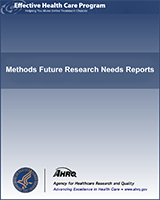NCBI Bookshelf. A service of the National Library of Medicine, National Institutes of Health.
Systematic reviews and other secondary research reports that are based on data from multiple sources, such as decision or cost-effectiveness analyses, often conclude by noting gaps in the available evidence and make recommendations for future research. Potential users of these recommendations include policy makers and funders, as well as healthcare researchers. The purpose of this project is to determine an optimal format for presenting a new type of product of the Evidence-based Practice Center (EPC) Program, the Future Research Needs documents. In particular, we address the following questions: What level of specificity is needed by various funders or researchers for a research needs document to be useful? How can one categorize and present research needs? What are the specific barriers to making a research needs document useful to researchers and funders?
To answer these questions, we performed an empirical assessment of the literature to understand how future research needs have been presented in the published literature, and sought feedback from healthcare researchers, research funders, or payers in the form of open-ended interviews. Based on the results of the empirical assessment and the qualitative interviews we outline the preliminary recommendations. Future research needs documents for the EPC program should provide succinct yet adequate description of methods and results following guidelines for reporting for qualitative research and modeling, as applicable. It is important to justify the selection of the stakeholders who participate in identifying or prioritizing research needs, and to be clear on their degree of engagement. It may be useful to report results of future research needs assessments at two levels of detail: the more abstract level would mention general areas of future research without details on potential research designs or specific details on e.g., populations, interventions and outcomes, which could be elaborated in the second level. It may be preferable to avoid explicit prioritization of research needs when there are no clear differences in the perceived strength of alternative recommendations. Overall, future research needs recommendations are projections and therefore should not be prescriptive.
Contents
- Preface
- Background
- Methods
- Results
- Discussion and Conclusions
- References
- Abbreviations
- Apppendixes
- Appendix A. Search Strategies
- Appendix B. Included and Excluded Studies for the Empirical Assessment of Systematic Reviews
- Appendix C. Included and Excluded Studies for the Empirical Assessment of Cost-Effectiveness Analyses
- Appendix D. Included and Excluded Studies for the Empirical Assessment of Value of Information Analyses
Suggested citation:
Trikalinos TA, Dahabreh IJ, Lee J, Moorthy D. Methods Research on Future Research Needs: Defining an Optimal Format for Presenting Research Needs. Methods Future Research Needs Report No. 3. (Prepared by the Tufts Evidence-based Practice Center under Contract No. 290-2007-10057-I.) AHRQ Publication No. 11-EHC027-EF. Rockville, MD: Agency for Healthcare Research and Quality, June 2011. Available at: www.effectivehealthcare.ahrq.gov/reports/final.cfm.
This report is based on research conducted by the Tufts Evidence-based Practice Center under contract to the Agency for Healthcare Research and Quality (AHRQ), Rockville, MD (Contract No. 290-2007-10057-I). The findings and conclusions in this document are those of the author(s), who are responsible for its content, and do not necessarily represent the views of AHRQ. No statement in this report should be construed as an official position of AHRQ or of the U.S. Department of Health and Human Services.
The information in this report is intended to help clinicians, employers, policymakers, and others make informed decisions about the provision of health care services. This report is intended as a reference and not as a substitute for clinical judgment.
This report may be used, in whole or in part, as the basis for the development of clinical practice guidelines and other quality enhancement tools, or as a basis for reimbursement and coverage policies. AHRQ or U.S. Department of Health and Human Services endorsement of such derivative products or actions may not be stated or implied.
None of the investigators have any affiliations or financial involvement that conflicts with the material presented in this report.
- 1
540 Gaither Road, Rockville, MD 20850; www
.ahrq.gov
- NLM CatalogRelated NLM Catalog Entries
- The future of Cochrane Neonatal.[Early Hum Dev. 2020]The future of Cochrane Neonatal.Soll RF, Ovelman C, McGuire W. Early Hum Dev. 2020 Nov; 150:105191. Epub 2020 Sep 12.
- Review Evaluating the Potential Use of Modeling and Value-of-Information Analysis for Future Research Prioritization Within the Evidence-Based Practice Center Program[ 2011]Review Evaluating the Potential Use of Modeling and Value-of-Information Analysis for Future Research Prioritization Within the Evidence-Based Practice Center ProgramMyers E, Sanders GD, Ravi D, Matchar D, Havrilesky L, Samsa G, Powers B, McBroom A, Musty M, Gray R. 2011 Jun
- A qualitative systematic review of internal and external influences on shared decision-making in all health care settings.[JBI Libr Syst Rev. 2012]A qualitative systematic review of internal and external influences on shared decision-making in all health care settings.Truglio-Londrigan M, Slyer JT, Singleton JK, Worral P. JBI Libr Syst Rev. 2012; 10(58):4633-4646.
- A research roadmap for complementary and alternative medicine - what we need to know by 2020.[Forsch Komplementmed. 2014]A research roadmap for complementary and alternative medicine - what we need to know by 2020.Fischer F, Lewith G, Witt CM, Linde K, von Ammon K, Cardini F, Falkenberg T, Fønnebø V, Johannessen H, Reiter B, et al. Forsch Komplementmed. 2014; 21(2):e1-16. Epub 2014 Mar 24.
- Review Improving Access to and Usability of Systematic Review Data for Health Systems Guidelines Development[ 2019]Review Improving Access to and Usability of Systematic Review Data for Health Systems Guidelines DevelopmentTotten AM, Smith C, Dunham K, Jungbauer RM, Graham E. 2019 Feb
- Defining an Optimal Format for Presenting Research NeedsDefining an Optimal Format for Presenting Research Needs
Your browsing activity is empty.
Activity recording is turned off.
See more...
